中国科学技术大学:《正电子物理》课程教学讲稿(正电子在材料科学中的应用)01 正电子概况(1/2,主讲:叶邦角)
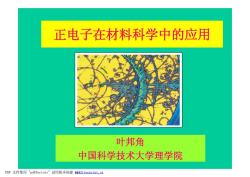
正电子在材料科学中的应用 叶邦角 中国科学技术大学理学院 PDF文件使用"pdfFactory”试用版本创建f3 fineprint.cn
正电子在材料科学中的应用 叶邦角 中国科学技术大学理学院 PDF 文件使用 "pdfFactory" 试用版本创建 3www.fineprint.cn ÿf3
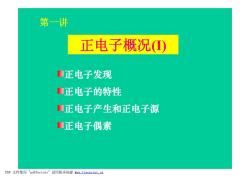
第一讲 正电子概况(① 山正电子发现 口正电子的特性 口正电子产生和正电子源 口正电子偶素 PDF文件使用"pdfFactory”试用版本创建ww.fineprint.cn
正电子概况(I) 第一讲 正电子发现 正电子的特性 正电子产生和正电子源 正电子偶素 PDF 文件使用 "pdfFactory" 试用版本创建 ÿwww.fineprint.cn
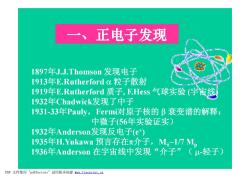
一、正电子发现 1897年J.J.Thomson 发现电子 1913年E.Rutherford粒子散射 1919年E.Rutherford质子,F.Hess气球实验(宇宙线 1932年Chadwick发现了中子 1931-33年Pauly,Fermi>对原子核的B衰变谱的解释: 中微子(⑤6年实验证实) 1932年Anderson发现反电子(e) 1935年H.Yukawa预言存在π介子,M~1/7M. 1936年Anderson在宇宙线中发现“介子”(u-轻子) PDF文件使用"pdfFactory”试用版本创建ww.fineprint..cn
一、正电子发现 1897年J.J.Thomson 发现电子 1913年E.Rutherford a 粒子散射 1919年E.Rutherford 质子, F.Hess 气球实验 (宇宙线) 1932年Chadwick发现了中子 1931-33年Pauly,Fermi对原子核的 b 衰变谱的解释: 中微子(56年实验证实) 1932年Anderson发现反电子(e+ ) 1935年H.Yukawa 预言存在p介子,Mp~1/7 Mp 1936年Anderson 在宇宙线中发现“介子”( m-轻子) PDF 文件使用 "pdfFactory" 试用版本创建 ÿwww.fineprint.cn
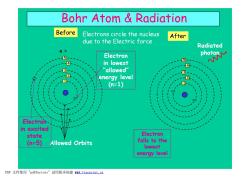
Bohr Atom Radiation Before Electrons circle the nucleus After due to the Electric force Radiated n= ⑤- Electron in lowest ph米 -④ 3- "allowed" 3- energy level (n=1) Electron- in excited state Electron (n=5) Allowed Orbits falls to the lowest energy level PDF文件使用"pdfFactory”试用版本创建ff.fineprint.cn
Electrons circle the nucleus due to the Electric force Bohr Atom & Radiation Allowed Orbits 1 2 3 4 5 n = Electron in lowest “ allowed” energy level (n=1) Electron in excited state (n=5) Before 1 2 3 4 5 Electron falls to the lowest energy level After Radiated photon PDF 文件使用 "pdfFactory" 试用版本创建 f www.fineprint.cn ÿf
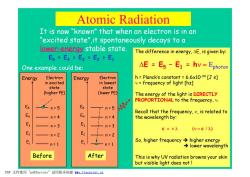
Atomic Radiation It is now "known"that when an electron is in an excited state",it spontaneously decays to a ower-energy stable state. The difference in energy,AE,is given by: E5>E4>E3>E2>E One example could be: AE E5-E1=hv=Ephoton Energy Electron Energy Electron h=Planck's constant=6.6x10-34 [J s] in excited in lowest v=frequency of light [hz] state state (higher PE) (lower PE) The energy of the light is DIRECTLY PROPORTIONAL to the frequency,v. n=5 n=5 n=4 E4 Recall that the frequency,v,is related to n=4 the wavelength by: n=3 n=3 c=V入 (V=c/) n=2 E2 n=2 E, So,higher frequency higher energy n=1 n-1 →lower wavelength Before After This is why UV radiation browns your skin but visible light does not PDF文件使用"pdfFactory'”试用版本创建w,fineprint.cn
Atomic Radiation The difference in energy, DE, is given by: DE = E5 – E1 = hn = Ephoton h = Planck’s constant = 6.6x10-34 [J s] n = frequency of light [hz] The energy of the light is DIRECTLY PROPORTIONAL to the frequency, n. Recall that the frequency, n, is related to the wavelength by: c = n l (n = c / l) So, higher frequency è higher energy è lower wavelength This is why UV radiation browns your skin but visible light does not ! It is now “known” that when an electron is in an “ excited state” ,it spontaneously decays to a lower-energy stable state. Before n = 1 n = 2 n = 3 n = 4 n = 5 Energy Electron in excited state (higher PE) E5 E4 E2 E3 E1 E5 > E4 > E3 > E2 > E1 After n = 1 n = 2 n = 3 n = 4 n = 5 Energy Electron in lowest state (lower PE) E5 E4 E2 E3 E1 One example could be: PDF 文件使用 "pdfFactory" 试用版本创建 ÿÿwww.fineprint.cn
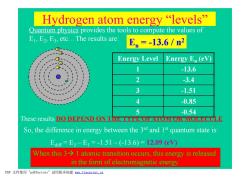
Hydrogen atom energy "levels" Quantum physics provides the tools to compute the values of E1,E2,E3,etc...The results are: En=-13.6/n2 -☑ 3- Energy Level Energy E (eV) -2 1 -13.6 2 -3.4 3 -1.51 4 -0.85 5 -0.54 These results DO DEPEND ON THE TYPE OFATOM OR MOLECULE So,the difference in energy between the 3d and 1st quantum state is: Eim=E3-E1=-1.51-(-13.6)=12.09(cV When this 31 atomic transition occurs,this energy is released in the form of electromagnetic energy. PDF文件使用"pdfFactory”试用版本创建www.fineprint.cn
Hydrogen atom energy “levels” Quantum physics provides the tools to compute the values of E1 , E2 , E3 , etc…The results are: En = -13.6 / n2 Energy Level Energy En (eV) 1 -13.6 2 -3.4 3 -1.51 4 -0.85 5 -0.54 So, the difference in energy between the 3rd and 1st quantum state is: Ediff = E3 – E1 = -1.51 – (-13.6) = 12.09 (eV) When this 3à 1 atomic transition occurs, this energy is released in the form of electromagnetic energy. These results DO DEPEND ON THE TYPE OF ATOM OR MOLECULE 1 2 3 4 5 PDF 文件使用 "pdfFactory" 试用版本创建 www.fineprint.cn

Some Other Quantum Transitions Initial Final Energy diff. Energy diff. Wavelength Region State State [eV] [ [nm] 2 1 10.2 1.6x1018 121 X-ray 3 1 12.1 1.9x1018 102 X-ray 4 1 12.8 2.0x10-18 97 X-ray 3 2 1.89 3.0x10-19 654 Red 4 2 2.55 4.1x10-19 485 Aqua 5 2 2.86 4.6x1019 432 Violet 400 450 500 550 600 650 700 750 (ultra)Violet Blue Cyan Green Yellow Orange Red (infra) PDF文件使用"pdfFactory”试用版本创建www.fineprint.cn
Some Other Quantum Transitions Initial State Final State Energy diff. [eV] Energy diff. [J] Wavelength [nm] Region 2 1 10.2 1.6x10-18 121 X-ray 3 1 12.1 1.9x10-18 102 X-ray 4 1 12.8 2.0x10-18 97 X-ray 3 2 1.89 3.0x10-19 654 Red 4 2 2.55 4.1x10-19 485 Aqua 5 2 2.86 4.6x10-19 432 Violet PDF 文件使用 "pdfFactory" 试用版本创建 www.fineprint.cn
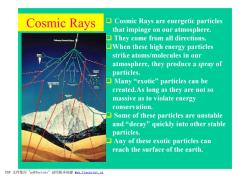
Cosmic rays Cosmic Rays are energetic particles that impinge on our atmosphere. Primary Cosmlc Rays They come from all directions. When these high energy particles strike atoms/molecules in our atmosphere,they produce a spray of particles. Many“exotic”particles can be created.As long as they are not so massive as to violate energy conservation. Some of these particles are unstable and“decay”quickly into other stable particles. Any of these exotic particles can reach the surface of the earth. PDF文件使用"pdfFactory”试用版本创建ww.fineprint.cn
Cosmic Rays q Cosmic Rays are energetic particles that impinge on our atmosphere. q They come from all directions. qWhen these high energy particles strike atoms/molecules in our atmosphere, they produce a spray of particles. q Many “exotic” particles can be created.As long as they are not so massive as to violate energy conservation. q Some of these particles are unstable and “decay” quickly into other stable particles. q Any of these exotic particles can reach the surface of the earth. PDF 文件使用 "pdfFactory" 试用版本创建 ÿwww.fineprint.cn
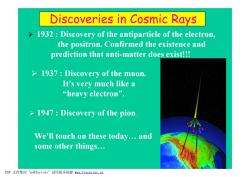
Discoveries in Cosmic Rays >1932 Discovery of the antiparticle of the electron, the positron.Confirmed the existence and prediction that anti-matter does exist!!! >1937:Discovery of the muon. It's very much like a "heavy electron'”. >1947:Discovery of the pion We'll touch on these today...and some other things... PDF文件使用"pdfFactory”试用版本创建ww.fineprint.cn
Discoveries in Cosmic Rays Ø 1932 : Discovery of the antiparticle of the electron, the positron. Confirmed the existence and prediction that anti-matter does exist!!! Ø 1937 : Discovery of the muon. It’s very much like a “heavy electron” . Ø 1947 : Discovery of the pion. We’ll touch on these today… and some other things… PDF 文件使用 "pdfFactory" 试用版本创建 ÿwww.fineprint.cn
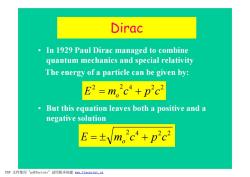
Dirac In 1929 Paul Dirac managed to combine quantum mechanics and special relativity The energy of a particle can be given by: E2=m,2c4+p2c2 But this equation leaves both a positive and a negative solution E=±Vm,2c4+p2c2 PDF文件使用"pdfFactory”试用版本创建www.fineprint.cn
Dirac • In 1929 Paul Dirac managed to combine quantum mechanics and special relativity The energy of a particle can be given by: • But this equation leaves both a positive and a negative solution 2 2 4 2 2 E m c p c = o + 2 4 2 2 E m c p c = ± o + PDF 文件使用 "pdfFactory" 试用版本创建 www.fineprint.cn
按次数下载不扣除下载券;
注册用户24小时内重复下载只扣除一次;
顺序:VIP每日次数-->可用次数-->下载券;
- 中国科学技术大学:《Muon物理》课程教学讲稿(技术及其应用)第二讲 慢正Muon束的产生 Low energy positive muons beam.pdf
- 中国科学技术大学:《Muon物理》课程教学讲稿(技术及其应用)第一讲 Muon的基本慨况(主讲:陈祥磊)μ(muon)子简介.pdf
- 中国科学技术大学:《物理学》课程教学资源(科普报告)医学物理的发展与展望(我国医学物理发展的思考).pdf
- 中国科学技术大学:《物理学》课程教学资源(科普报告)正电子在材料科学中的应用.pdf
- 中国科学技术大学:《物理学》课程教学资源(科普报告)反物质探索.pdf
- 中国科学技术大学:《物理学》课程教学资源(科普报告)核物理与核技术的发展与应用(主讲:叶邦角).pdf
- 中国科学技术大学:《电磁学》课程教学资源(专题报告)巨磁电阻效应及应用(主讲:李晓光).pdf
- 中国科学技术大学:《电磁学》课程教学资源(专题报告)表面分析中的电与磁(主讲:张增明).pdf
- 中国科学技术大学:《电磁学》课程教学资源(专题报告)只是应用于iPOD的GMR——漫谈2007诺贝尔物理奖(主讲:朱弘).ppt
- 中国科学技术大学:《电磁学》课程教学资源(专题报告)单原子分子测控(主讲:徐春凯).ppt
- 中国科学技术大学:《电磁学》课程教学资源(专题报告)Using Multi-gap Resistive Plate Chamber as TOF.ppt
- 中国科学技术大学:《电磁学》课程教学资源(专题报告)物质的磁性及其应用(主讲:张泰永).ppt
- 中国科学技术大学:《电磁学》课程教学资源(专题报告)加速器与同步辐射(主讲:戚伯云).ppt
- 中国科学技术大学:《电磁学》课程教学资源(专题报告)铁电物理研究新进展 New Progress in Ferroelectrics(主讲:王忆).ppt
- 中国科学技术大学:《电磁学》课程教学资源(专题报告)反物质探索(主讲:叶邦角).pdf
- 中国科学技术大学:《电磁学》课程教学资源(专题报告)等离子体物理及应用.ppt
- 中国科学技术大学:《电磁学》课程教学资源(专题报告)超导电性与磁性.pdf
- 《电磁学》课程教学资源(拓展资料)MIT-ID Interference and Diffraction.pdf
- 《电磁学》课程教学资源(拓展资料)麦克斯韦方程和规范理论的观念起源(杨振宁)maxwell-y.pdf
- 《电磁学》课程教学资源(拓展资料)Exam and Solutions Exam 2 Practice Problems Part 1 Solutions.pdf
- 中国科学技术大学:《正电子物理》课程教学讲稿(正电子在材料科学中的应用)02 正电子概况(2/2).pdf
- 中国科学技术大学:《正电子物理》课程教学讲稿(正电子在材料科学中的应用)03 正电子技术及其发展(1/2).pdf
- 中国科学技术大学:《正电子物理》课程教学讲稿(正电子在材料科学中的应用)04 正电子技术及其发展(2/2).pdf
- 中国科学技术大学:《正电子物理》课程教学讲稿(正电子在材料科学中的应用)正电子技术在材料科学中的应用(Low-k材料)Low-k materials.pdf
- 中国科学技术大学:《正电子物理》课程教学讲稿(正电子在材料科学中的应用)12 正电子技术在材料科学中的应用(Positron for Nano-particles).pdf
- 中国科学技术大学:《正电子物理》课程教学讲稿(正电子在材料科学中的应用)13 Positronium Bose-Einstein Condensation.pdf
- 中国科学技术大学:《正电子物理》课程教学讲稿(正电子在材料科学中的应用)14 正电子技术及其发展 Pulsed positron beam and its application.pdf
- 中国科学技术大学:《正电子物理》课程教学讲稿(正电子在材料科学中的应用)05 正电子技术及其发展(其它正电子技术).pdf
- 中国科学技术大学:《正电子物理》课程教学讲稿(正电子在材料科学中的应用)06 正电子技术及其发展(正电子技术的发展).pdf
- 中国科学技术大学:《正电子物理》课程教学讲稿(正电子在材料科学中的应用)07 正电子技术在材料科学中的应用.pdf
- 中国科学技术大学:《正电子物理》课程教学讲稿(正电子在材料科学中的应用)08 正电子技术在材料科学中的应用(半导体).pdf
- 中国科学技术大学:《正电子物理》课程教学讲稿(正电子在材料科学中的应用)09 正电子技术在材料科学中的应用(介孔材料).pdf
- 中国科学技术大学:《科学与社会》课程教学资源(研讨讲稿)反物质研究.pdf
- 中国科学技术大学:《科学与社会》课程教学资源(研讨讲稿)反物质的若干问题.pdf
- 中国科学技术大学:《科学与社会》课程教学资源(研讨讲稿)狄拉克是如何预言反物质的.pdf
- 中国科学技术大学:《科学与社会》课程教学资源(研讨讲稿)正电子科学与技术.pdf
- 中国科学技术大学:《科学与社会》课程教学资源(参考资料)CDB-1 Momentum Distribution Techniques.pdf
- 中国科学技术大学:《科学与社会》课程教学资源(参考资料)CDB-2 实验原理.docx
- 中国科学技术大学:《固体物理》课程教学资源(课件讲稿)第一章 晶体结构 Crystal Structure 1.1 晶体结构的周期性、晶体点阵.pdf
- 中国科学技术大学:《固体物理》课程教学资源(课件讲稿)第一章 晶体结构 Crystal Structure 1.2 晶体的对称性——晶系、点群、空间群.pdf
